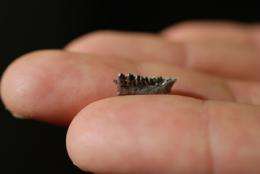The African origin of anthropoid primates called into question

Well-preserved craniodental fossil remains from two primate species have been discovered during excavations at an Algerian site. They reveal that the small primate Algeripithecus, which is 50 million years old and until now was considered as the most ancient African anthropoid, in fact belonged to another group, that of the crown strepsirhines.
This research was carried out by a team of French researchers from the Institut des Sciences de l'Evolution (Université de Montpellier, France), working with Algerian paleontologists from the universities of Tlemcen, Oran and Jijel. The resulting publication, published online on the website of the Proceedings of the Royal Society B (Biological Sciences) on September 9, 2009, reopens the debate on the African origin of anthropoids, the group to which humans and apes belong.
In 1992, fossilized remains of the small primate Algeripithecus were discovered in the Algerian Sahara. Fifty million years old, weighing just 75 g and known to paleontologists thanks to the remains of two molars, this primate was considered to be the most ancient anthropoid of the African continent. The discovery of Algeripithecus was thus a major contribution to the hypothesis under which Africa was the cradle of anthropoid primates, a group to which humans and apes all belong. The existence of another primate, the Azibius, has been known for longer. This is one of the most ancient African representatives of the crown strepsirhines, another primate group that today is represented by the lemurs of Madagascar, the galagos of Central Africa and the loris of Southern Asia.
At the Glib Zegdou site in north-eastern Algeria, the French team, working in collaboration with Algerian scientists, recently exhumed cranial and dental fragments from both Algeripithecus and Azibius. They included some nearly complete mandibles. These remains displayed a certain number of traits typical of the crown strepsirhines, notably an adaptation to nocturnal activity and the putative presence of a "toothcomb" in the lower toothrow. The paleontologists concluded that Algeripithecus, like its close relative Azibius, did not in fact belong to the family of anthropoid primates but was very probably one of the most ancient representatives in Africa of the crown strepsirhines.
In Egypt, the presence of more than a dozen fossilized anthropoid primates dating from 30 to 38 million years ago had long been known. This recent Franco-Algerian discovery thus advances the first true appearance of anthropoid primates on the African continent by more than 15 million years. With its major consequences on the evolutionary history of African anthropoid primates, this observation further strengthens the alternative hypothesis of an Asiatic origin for anthropoids. Furthermore, this paleontologic research reveals a hitherto unsuspected diversity and great antiquity of the first crown strepsirhines in Africa.
More information: Tabuce R, Marivaux L, Lebrun R, Adaci M, Bensalah M, Fabre P-H, Fara E, Gomes-Rodrigues H, Hautier L, Jaeger J-J et al. 2009. Anthropoid vs. strepsirhine status of the African Eocene primates Algeripithecus and Azibius: craniodental evidence. Proceedings of the Royal Society of London. Published online before print September 9, 2009, doi: 10.1098/rspb.2009.1339.
Source: CNRS
















